An Assurance with Lichens to Contribute to Photopedogenic Soil Development on Mars and Even on Moon-First Ever Approximation
Richa Roy1, Sanjeet K Sharma2 and Bipin B Mishra3*
1Post Graduate Department of Biotechnology, TM Bhagalpur University, Bhagalpur
2Department of Computer Applications, TNB College, TM Bhagalpur University, Bhagalpur
Submission:July 07, 2025; Published: August 21, 2025
*Corresponding author:Bipin B Mishra, Former Chief Soil Survey Officer (Bihar), BAU Sabour, 813210; Former Professor, Pedology & Land Use Planning, UNDP-Haramaya University, Ethiopia; Former Vice Chair, Commission 1.4 (Soil Classification), International Union of Soil Sciences
How to cite this article:Richa Roy, Sanjeet K Sharma and Bipin B Mishra. An Assurance with Lichens to Contribute to Photopedogenic Soil Development on Mars and Even on Moon-First Ever Approximation. Adv Biotech & Micro. 2025; 19(1): 556005.DOI:10.19080/AIBM.2025.19.556005
Abstract
Humans have successfully landed on both Moon as well as Mars under very extreme environmental situations, not favorable for pedogenic or photopedogenic processes for soil development as normally possible on Earth. However, almost like Earth, basalt and other similar rocks and their small pieces are abundantly available on Moon and Mars surfaces. Such broken dust materials both from Moon and Mars were brought to Earth by giving a common name “regolith” (<2mm size, mm) for simulation studies on the Earth. More emphasis was given to basalt, since basalt is more generative through its mode of weathering under extreme environment existing on Moon and Mars surfaces besides possible scope with microbial communities including lichens. It is not a surprise for a soil to be developed when it’s parent materials, associated climate, sunlight, surrounding atmosphere, roughness of surface (topography) including vegetative cover (organic matter) and biodiversity are present. On moon and mars, the rocks dominated by basalt are present on both. However, the physical as well as environmental conditions are very distinct and extreme for pedogenic weathering. The existence of microorganism especially lichens may tolerate harsh conditions on Mars. Lichens being phototropic require sunlight for photosynthesis and the weak sunlight on Moon and Mars. Lichens are symbiotic organisms composed of fungi and algae or cyanobacteria. The existence of lichens on basalt or other mineral surface lead to promote organic matter and carbon and enhance possibilities of weathering of rocks and minerals. These challenges lie on survival and weathering of basalt surface. Such weathering following oxidation of basaltic minerals changes basalt from dark grey or black to yellowish or reddish or brownish. The result of weathering of basalt on colour may be yellowish-brown or red identical to the common colour of honey. The so developed soils on Mars or even on lunar surface to look like the colour of honey as such the actual soil especially on Mars in days to come would referably resemble the colour of honey. As such the proposed soil would be designated as Hanisols under WRB, although such tentative nomenclature would be verified in days to come when such Hanisols would be studied on Mars and Mon exhaustively. Artificial Intelligence (AI) unlocks the mystery of possible soil genesis on Moon and Mars.
Keywords: Lunar Soils; Martian Soils; Photopedogenesis; Harsh Environment; Hanisols; Basalt; Lichens; Artificial Intelligence
Abbreviations: IARI: Indian Agricultural Research Institute; BAU: Bihar Agricultural University; NRL: Nuclear Research Laboratory; NASA: National Aeronautics and Space Administration; UNO: United Nations Organisation; WRB: World Reference Base for Soil Resources
Introduction
Soil is a strange, full of wisdom and store house of biodiversity that needs to be discovered in order to fix its exploitation for sustainable management as a natural resource of the Earth. However, there is virtually no soil either on Moon or Mars, although men attempted to successfully land on both Moon and Mars surfaces. During such space journeys, lunar and Mars surfaces are partly discovered and being further studied systematically about nature of their surfaces, atmospheric stability, sunshine direction variations, radiation challenges, environmental barriers, gravitational weaknesses, climatic barriers, microbial communities, water availability, etc. However, both Moon and Mars do have almost identical rocks and minerals, usually broken into pieces and dust. Among rocks, basalt is present dominantly on both Moon and Mars surfaces in association with other rocks and minerals. Very specifically, mixed rock-mineral materials on lunar as well as Mars surface is conveniently called lunar or martial “regolith”. Such surface fine broken materials either from Moon or Mars are not the true soil of pedogenic origin but frequently used as pseudo-soil of Moon or Mars for simulation on Earth to conduct experiments of specific objectives.
[1] Observed that bacteria may increase the bioavailability of minerals in simulated regolith using inoculate of Pseudomonas species, Pseudomonas aureofactens and others. Besides those bacteria were also able to reduce toxic levels of Na, Zn, Ni, Fe by upto 50% within plant tissues. Thus, microorganisms may be used as a tool for conditioning the lunar and Martial basalt for plant growth and nutrient uptake. Martian soil however indicates limited water holding capacity due to virtually no organic carbon. This can be improved likely by bacteria and produce polysaccharides or adhesive proteins that bind soil particles and thus increase the moisture levels of soil [2]. Both Martian and lunar regolith may be promising soil resources. However, they may contain heavy metals like lead, cadmium, chromium and arsenic [3,4]. It is reported that E. coli and B. subtilis may remove impacts of lead, cadmium and chromium [5].
Soil classification vs soil identification
On terrestrial Earth, origin or formation of soil is fully defined, characterized and classified following the principles, processes and genetic chains varying across the globe. The soil forming factors and processes are well defined and established. Recently photopedogenesis is added as a fundamental soil forming process highlighting solar radiation as the vital factor in formation and development of soil as a 3- dimensional natural body on Earth or Moon [6]. Both Moon and Mars are extraterrestrial planetary bodies differing in atmosphere almost negligible, sun light intensity and radiation including ultraviolet intensity, surface minimum and maximum temperatures, absence of life forms or biodiversity, maximum and minimum temperatures, acidity-alkalinity, salinity, absence of oxygen gas and water mostly in ice form. Of course, rocks and minerals are almost identical to those on the Earth following specific differences in geology and geomorphology of Moon and Mars.
Relief or simply topographic situation either on Moon or Mars is by and large almost prevalent as on Earth. Climate on Moon and Mars is challenging and distinct from Earth. Vegetation is virtually non- existence and water is of course in existence but mostly in ice forms. By and large, pedogenic situations are inhospitable and extreme for soil formation and subsequent development. Accordingly, it is imperative to establish the favourable situation for the genesis of soil unless we have soil formation as well as development either on lunar and Martian surface (Figure 1) there is no scope for soil classification as such. So, one has to examine the mode of soil formation as 3-dimensional natural body being easily hospitable for biological abundance, atmospheric resilience and delation threats including hospitable day and night temperature and water access. As such, first of all one has to fix soil being formed or developed as 3-dimensional natural body in lunar and Martian landscape, efforts directly think for soil classification does not fulfil any purpose.
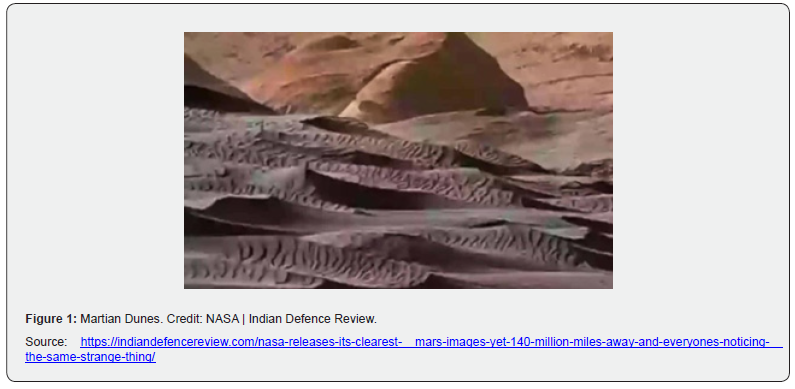
Weathering of basalt
Weathering of basalt on both Moon and Mars surfaces encounter and face uniquely existing extreme environmental challenges being entirely different from Earth. Both the Moon and Mars are gifted with extremely challenging thin atmospheres as well as very limited water sources with virtually no or negligible organic source or life. This simply signifies that physical weathering processes dominate on both Moon and Mars, whereas chemical weathering are playing only restricted minor roles following some distinctions as follows:
On Moon, the mechanical weathering due to thermal stress as well as micrometeoroid impacts dominating. Extreme temperature variations between day and night cause expansion and contraction of basalt leading to breakdown of basalt. The frequent bombardment of lunar surfaces by small meteoroid grinds down the basalt into pieces forming so-called lunar regolith. Additionally, the limited or even absence of “liquid water” (not ice water) as well as “a very thin atmosphere” restricts chemical weathering of basalt so desired. However, there is no documentation of life source on lunar surface.
Contrary to lunar surface, the weathering situation of basalt on Mars is somehow distinct from Moon. In fact, Martian atmosphere is of course thin, but it carries dust and sand loading to wind abrasion and erosion of basalt. Liquid water flows on Mars may cause chemical weathering resulting in colour change, clay minerals and secondary mineral formation besides some expected acids being formed during chemical weathering of basalt. Besides, presence of salts on Mars surface may contribute to weathering through hydration cycles. Additionally, atmospheric gas like carbon dioxide and even mineral oxygen may cause chemical alterations of basalt. [7] in their recent findings observed that on Mars, top-down leaching in Martian geological history results clay mineral bearing stratiographics and such situations occur in areas where chemical weathering was favoured over physical erosion nearer to standing water bodies.
Risk on lunar surface in sun-facing site
Major risks on Lunar Surface specially in sun-facing site may
be enlisted as follows:
i. Lack of nutrients in lunar regolith (pieces of rocks and minerals)
ii. no organic matter or organic carbon
iii. abnormally extreme temperature fluctuations
iv. low gravity compared to earth
v. negligible or very poor water retention capacity of lunar
regolith
vi. very high toxicity levels of elements in regolith and
vii. acute shortage of aeration (Figure 2)
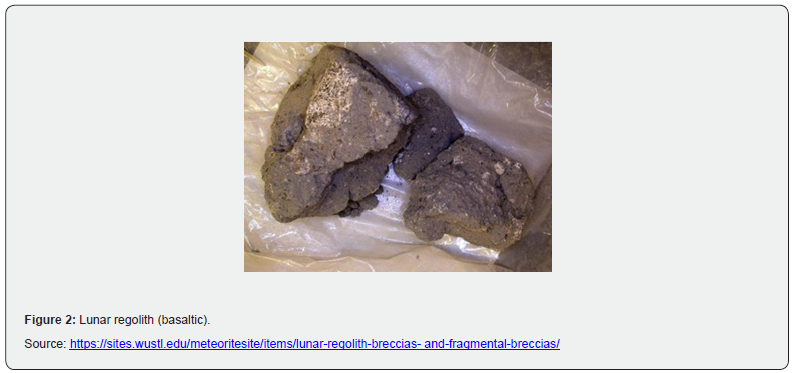
Thus, such adverse situations are naturally existing on lunar surface where normal agriculture cannot be possible. Even the terrestrial (Earth) microbes into lunar environments could disrupt the lunar ecosystem. However, Indian Chandrayan 3 has recently hopefully ascertained water in lunar regolith with some way. The Chandrayan 3 mission of ISRO lander near the moon South Pole (Shivshakti point) on 23rd August 2023 disclosed as under: (i) Surface temperature at a flat side was 58.86-degree celcius. The findings further indicates that water ice move widespread than it was previously anticipated. The frozen water resources could be used even for drinking purposes, cooling devices and instruments and even for producing oxygen gas. Such water ice may provide a habitat for microbes which could be a scope for life on moon. In general, plants growing in space may experience challenges due to low gravity which normally disturbs root development and water uptake and distribution.
[8] in their recent publication reported that the Vikram lander of Chandrayaan 3 has provided in-situ temperature profile near south polar region of the moon regolith (broken pieces of lunar surface rocks and minerals) temperature upto a depth of 10 cm at a high latitude highland region of the lunar south pole over a major fraction of lunar day. The peak surface temperature at Shivshakti landing site is 355 K, a temperature relatively higher.
NASA and ISRO successfully reach lunar surface. Chandrayaan 1 and 3 also successfully discovered many hidden truths (Figure 3) Interestingly the earth bacteria could survive on the moon for decades (Universe Today; https://www.universetoday.com). NASA has confirmed the existence of water molecules, H2O in sunlit area of the moon and thus indicating that water in reality widely distributed across the lunar surface (http://science.nasa.gov). Water exists on the moon chiefly in the form of ice. Water exists both in permanently shadowed parts around the poles as well as in sunlit lunar areas locked in minerals on south of moon. India’s ISRO was the first to discover water locked in minerals on moon initially through Chandryaan 1 in 2008 using NASA’s Moon Mineralogy Mapper and confirmed the presence of water molecules on lunar surface especially at poles. However, the implication of such findings are high since water on moon would open the door for lunar agriculture in days to come. ISRO has already a patent for method of developing artificial lunar soil simulant known as Moon Soil on May 18, 2020.
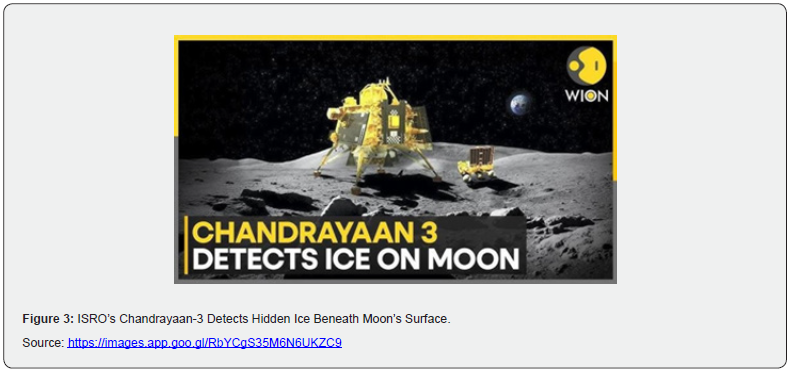
The production of oxygen is of challenge on lunar surface. This may be possible through thermo-chemical reduction of the lunar regolith, since moon does not have an atmosphere like earth. Lunar atmosphere is said to be very thin, composed mostly of hydrogen, neon and argon. In fact, there is plenty of oxygen on lunar surface but not in a gaseous form. The lunar oxygen is trapped inside regolith mineral structures forming the lunar surface of moon. The existing materials on lunar (moon) surface is nothing but regolith, which is not any true soil as defined in Pedology or even in Photopedogenesis by [6]. However, each cubic metre of lunar regolith contains 1.4 tons of minerals on an average including around 630 kg of oxygen by weight. An estimate indicates that humans need to breathe around 800 g of oxygen a day to survive on an average. On an average, 630 kg oxygen would keep a healthy person alive for about two years or even more. Now, if the average depth of so- called lunar regolith being considered is 10 m for use to estimate the possible outcome for oxygen gas, the top 10m of moon surface would provide enough oxygen (gas) to support all 8 billion on Earth for around 100,000 years, although this figure seems to be pretty unbelievable at a glance. In fact, minerals like silica, aluminium, iron and magnesium bearing oxides dominate the moon’s landscape. All such lunar minerals contain oxygen in mineral structures but not in the form of gaseous oxygen. In addition to above facts with lunar surface, it is further to add that moon’s surface is virtually inhospitable for life as well as possibility of microbial life in the permanently shadowed area of South Pole of moon (Shivshakti point) (Figure 4). It remains a subject of ongoing research to ensure microbial growth and seed germination. Microorganisms are sensitive to drastic changes in their environments. Extreme temperature, pressure, drought, salinity and pH fluctuations disrupt the crucial interactions that keep the biomolecules folded and functional and thus quickly destroying the cellular integrity [9].
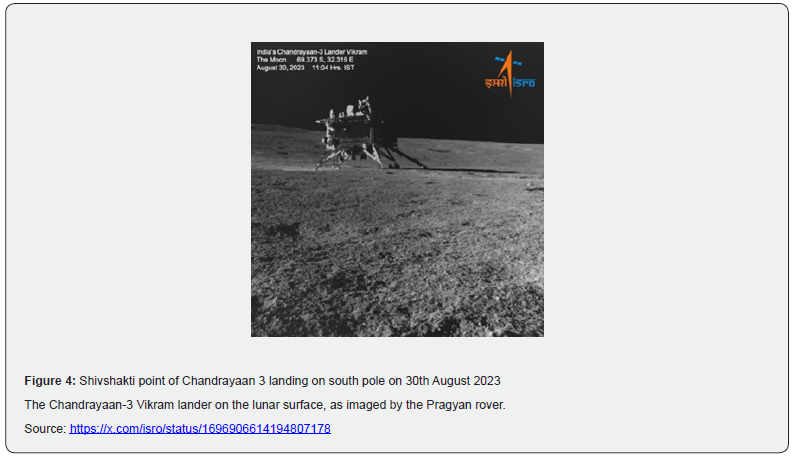
Rampelotto (2021) demonstrated that microorganisms may survive under extreme conditions like ultracentrifugation, hypervelocity, shock pressure, high temperature variations, vacuums, UV and ionizing radiation intensity, which simulate the conditions that microbes could experience during ejection from planet. Attempts are made subsequently with lunar regolith brought to earth for its suitability for growing some selected plant types in prepared lunar regolith simulants of specific purposes [10]. Observed that P- solubilizing bacteria improved the available P content of the regolith simulant and improve the fertility and growth of plants. Such preliminary results may lay a technical foundation gradually for plant cultivation based on lunar regolith resources in future lunar bases on moon. Lunar soil and its simulant is not a suitable substrate for planting as it ĺacks organic matter and nutrients besides negligible physical features like no or very poor water and nutrient, very poor permeability and damaging root system [11]. However, attempted to develop the ways suitable for cultivation in lunar regolith.
Moon’s surface is made up of basalt, anorthrite and breccia besides other mixed or associated minerals including zeolite (Figure 5). However, basalt is regenerative in changing environment relatively more than other existing materials. The ice or water drops on lunar surface slowly move downwards against lunar gravitational force through the cracks on basalt and this lunar water facilitates physical weathering of gradual colour change on basaltic surface. Such physical weathering of basalt turns its original blackish colour to somewhat whitish and subsequently to brownish, almost identical to colour of common “honey” in India. The lunar basalt (Figure 6) in continuous contact with ice or water undergoes physical change in colour followed by specific chemical change in a long pedogenic chemical reorganization to give the pedogenic shape of a soil being designated as Hanisols [12,13], a proposed soil group in WRB (Figure 7).
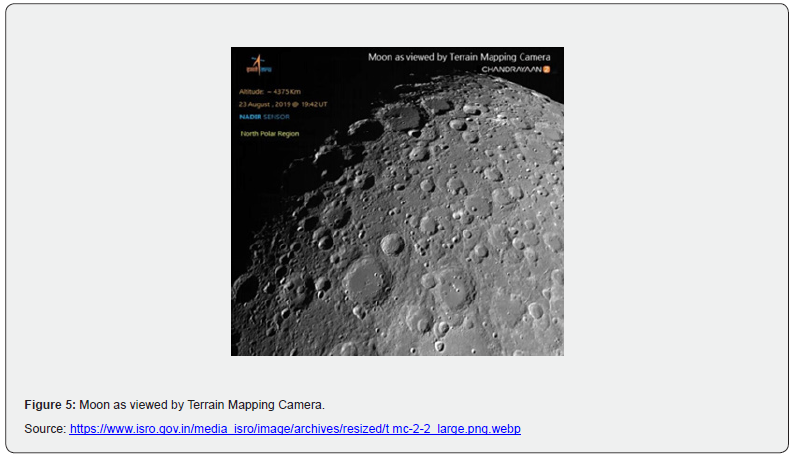
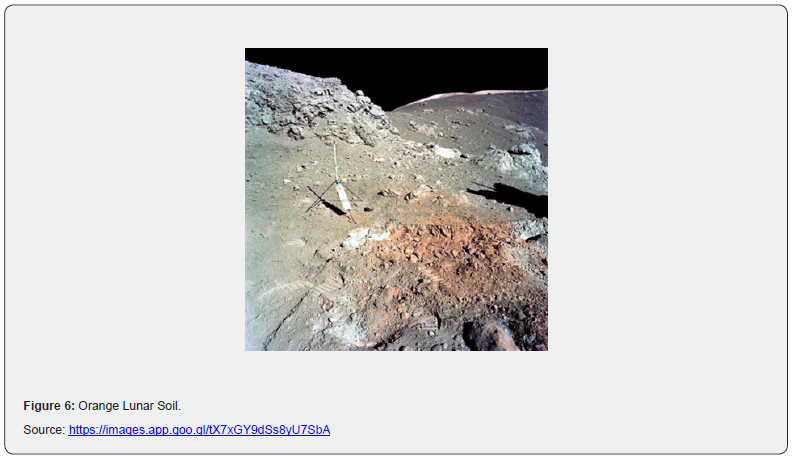
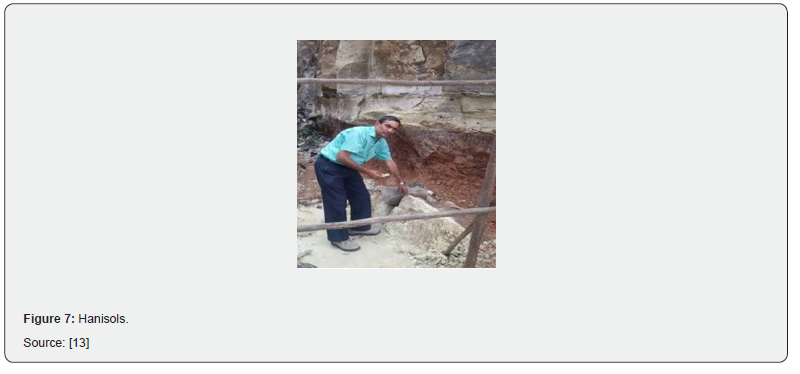
[14] Attempted to study the Lunar and Martian simulants and observed vital lack of nutrients, organic matter and physical features. However, manure amendments improved chemical properties of simulants as well as nutrient availability. Physico-hydraulic properties of both simulants were enhanced by organic fertilization. Almost 70:30 (simulant: manure) was best in terms of fertility.
Pedological challenges in moon and mars
It is well documented that microbes may survive under extreme conditions of surroundings [15]. Such extreme environmental conditions are often required for survival of specific microbes (Pikuta & Hoover 2007). These conditions may include physical extremes like temperature, pressure and radiation, geochemical extremes like desilication, salinity, alkalinization, pH, redox potential [16]. Normally microbes may thrive at 6-7 km depth within the Earth crust and more than 10 km deep inside the deep ocean at atmospheric pressure of around 110 Mpa from extreme acid (pH 0) to extreme basic, pH 12.8 (Lupoz-Garcia 2008). However, microorganisms under diversity of extremophic microbes may be Thermophiles and Hyperthermophiles, Acidophilus, Alkaliphiles, Haplophiles or Piezophiles [15].
Also, it may be plausible that somehow wet basalt either on Moon or even Mars may promote lichen growth even under poor sunlight or shadow. It may be hard but due to certain inherent growth features of lichen. Besides lichen is considered to be a photosynthetic species fascinated to energy requirements. Normally existing light may be adequate for energy need to lichen. The food source of nutrients for lichen could be made available from nutrients extracted from basalt. By and large, lichen has ability to withstand extreme environmental conditions like low light intensity and poor water availability. The lunar basalt in continuous contact with ice or water undergoes physical change in colour followed by specific chemical change in a long pedogenic chemical reorganization to give the pedogenic shape of a soil being designated as Hanisols, a proposed soil group in WRB [13].
Microbiomes are complex communities of microorganisms that are essential for biochemical processes on Earth. Some environmental and host-associated microbiomes are dominated by anaerobic microbes, some of which cannot tolerate oxygen as studied recently by [17]. However, anaerobic microbial communities have been extensively studied over the last 20 years using molecular techniques, especially next-generation sequencing. However, there is a renewed interest in microbial cultivation because isolates provide the basis for understanding the taxonomic and functional units of biodiversity, elucidating novel biochemical pathways and the mechanisms underlying microbe-microbe and microbe-host interactions and opening new avenues for biotechnological and clinical applications.
Lichens
As studied by [18], Xanthoria parientina (L) is a widely spread foliose lichen showing high tolerance against UV-radiation, even when exposed under simulated Martian condition for active light reaction of photosynthesis. In fact, lichen inhabits diverse ecosystems globally on Earth. They are especifically crucial in extreme environments such as hot desert as well as cold polar regions. Such lichen are extremophiles, able to survive under extreme temperatures, intense radiation, prolonged water scarcity. As such, specific lichens are well suited. Lichens are by and large suitable organisms for experiment in astrobiology. The eco-physiological adaptability of different lichen species in extreme habitats is the key to understand their survival capacity even in space and extraterrestrial environments [18,19] Observed that weathering of minerals may be accelerated with the growth of at least some lichen species. The impact of lichens on their mineral substrates may be attributed to both physical and chemical processes. Lichens have significant impact in the chemical weathering of rocks by excretion of specific organic acids specifically oxalic acid, which may dissolve specific minerals as well as chelate metallic cations [19]. However, under key adaptation of extreme-tolerant lichens to extraterrestrial conditions prevailing on Mars and Moon are identified as Circinarea gyrosa by [20]. However, [19] recommended D. muscorum to be a promising lichen with potential habitability of Mars. Lichens are uniquely called extremophiles capable of enduring extreme and harsh environments like intense radiation, prolong water deficits as well as extreme temperature.
In fact, lichens are in symbiotic partnerships between fungi and algae or cyanobacteria, which have unique resilience to extreme environmental conditions and thus lichens may potentially survive on Moon and Mars surfaces (Figure 8). Now, basalt being igneous rock as we know on Earth is widely distributed on both Mars and Moon and initially looked dark grey to black. Under changing environmental situations tolerable to basalt, there is indications of undergoing chemical weathering processes, which lead to changes in colours preferably from dark to reddish or brownish and so. In fact, such colour change in basalt is attributed to the oxidation of Fe-rich minerals such as pyroxene, titanomagnetite etc. With such weathering of basalt, the Fe-rich minerals are oxidized, if oxygen are present and get oxidized. As a result, clays and olivine on way of such weathering results in colour change. Besides, basaltic cinders being associated preferentially are red in coloration besides pyroxene on Mars and possibly on lunar surface too. In cases, chemical weathering results in excess gain of aluminium, the basaltic weathered parts may look whitish even continued water exists below the surface of Mars or Moon as observed on Earth [12,13].
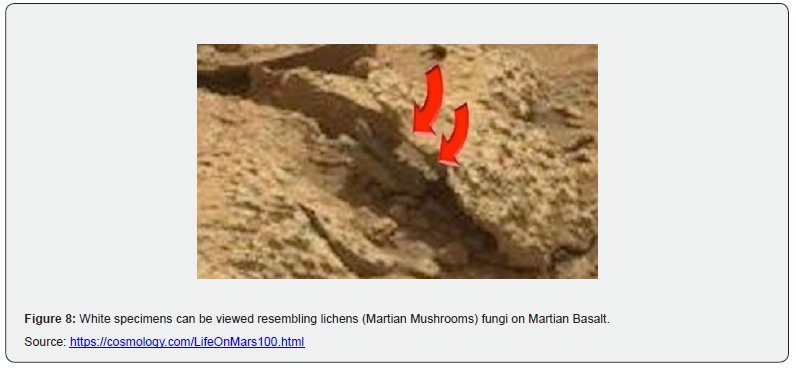
Lichens have shown their ability to survive in extreme environments even under simulated space conditions. Such resilience clearly indicates lichen’s capability to survive on the Moon as well as Mars despite the existing harsh conditions therein. Many lichen species are known as extremophiles. This simply means that they may thrive in conditions which may be lethal many other life forms or microorganisms. In fact, lichens have low metabolic rates and minimal nutrient requirements and so they may survive with limited available resources. However, lichens may survive under prolonged water shortage or even without liquid water. Researchers (Singh et al. 2025) from Desert Research Institute & University of Nevada Reno (UNR) found that a common lichen growing in the Mojave Desert may survive levels of ultraviolet radiation previously the same was thought to be lethal (Figure 9). The study shows that this humble desert lichen might hold the key to understanding how life could endure in extreme environments on other worlds like Mars and Moon in days to come.
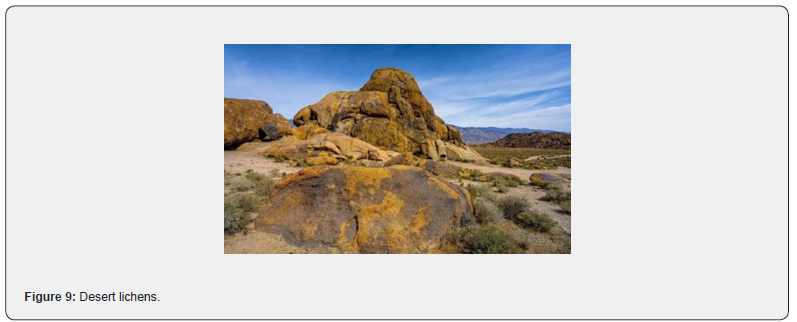
Distinct feature of basalt on earth
The results of [18] remarked that lichens are suitable organisms in astrobiology. The eco- physiological adaptability of different lichen species in extreme habitats is the key to understand their survival capacity in space and extraterrestrial [18]. The Martian surface has undergone chemical and physical weathering in the past and continues today, although the average surface temperature on Mars is -60 degree C, which may rise above 0 deg C as reported by [18]. In the highlands of Ethiopia, basalt in rainy season promotes the growth of lichens in presence of rain water and sun light. This gradually facilitates exfoliation and allowing water to move downwards through natural basaltic cracks (Figure 10) for years together. Once water get stagnated due to blockage caused by differing rock like granite or limestone, water moving through passage of basalt get accumulated facilitating weathering of basalt more intense. Such accumulated water is often used for irrigation Indiana watershed area of Ethiopia (Figure 11).
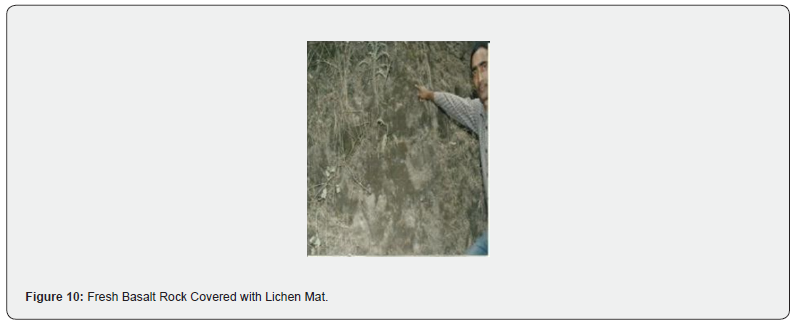
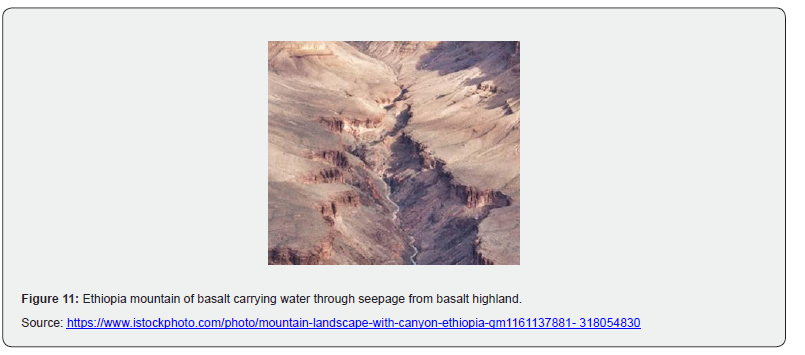
Visible sun light at about 1 cm sub-surface depth on Mars, visible light is still intense enough to be utilized by conceivable photosynthetic organisms, while the germicidal ultraviolet intensities at the Martian surface have been reduced to values manageable by terrestrial ecosystem and life [21-25].
Scope of artificial intelligence for in-depth studies
Using Artificial Intelligence (AI), we can analyze the composition of soils on Moon and Mars that can be identified for the potential resources and provide the mindset to assist to develop the ideas related to different experiments for the agricultural purposes even the existence of microorganism like lichens. AI supports to create simulation of different modules regarding the environment of Moon/Mars by comparing the atmosphere of Earth. AI tools normally use the machine learning concept to train different controlling components of rovers and space crafts for handling the activities in the critical situation and train their modules to handle the situation for its surrounding conditions. The AI tools may play a crucial role to analyse the dataset of Lunar and Martian surface to detect the different compositions of the surface as well as object identification, pattern matching, and interpretation of satellite imagery and send the data to earth observation satellites. Different space agencies use the concept of AI tools to develop the autonomous control of space crafts and rovers to analyze the datasets and diagnose the situations of the environment to detect anomalies for conditions existing.
Conclusions
No soil without life may be a fact, but is manageable within a given environment as of Moon and Mars, where our space scientists have landed and the surface dusts of so-called regolith were collected for simulation studies on Earth. Besides other rocks, both Moon and Mars have common basalt and ice or water. Physical weathering on both is common depending on variations in weathering factors. However chemical weathering is restricted. The biological weathering is by and large uncertain depending on our continued approached to introduce and develop microorganisms and lichens. With passage of time, all sunlight, weathered basalt, water and lichens would fascinate soil to develop on Mars and later Moon, when the harsh environment would be improved. The proposed soil as a natural resource in three dimensions would be named as Hanisols (proposed). We cannot even think for soil classification at this stage of beginning. Even pedology will be tilted to its new modified form, Photopedogenesis covering extraterrestrial environments of Mars and Moon.
There cannot be a soil in pedologic terms without involvement of some life forms. Life in some forms gives meaningful understanding of pedogenesis on Earth. However, even on Moon or Mars, we are searching for life forms capable to exist under harsh situations like lichens. Life beyond Earth is a challenge in common understanding. However, it is not impossible if existing situation is critically handled one by one. A conceptual term Alien may resemble human, but it is projected distinctly among humans on terrestrial Earth. By and large, it is believable to dream a pedogenically developed soil, but its functional integrity would possibly be distinct especially for agricultural production management in space like Moon or Mars. The proposed Hanisols may be tentative until detailed taxonomic grouping is established in World Reference Base. Moreover, systematic investigation both on Moon and Mars for pedogenic soil development is prerequisite. Conclusively, neither Moon nor the Mars could be suitable for raising any terrestrial plant in respective soils so proposed. This requires planned technological development and coherent management options to support anticipated outcomes desired. The extreme environmental conditions are by and large challenging at every step of regenerative innovation either on Moon or even Mars.
Certainly, the success is uncertain and will take enough time to undertake series of technological innovation. Hopefully, time will come when life establishes, where agriculture is gradually shaped within the existing framework but in existing changing situations being so defined. Conclusively, the future of life and agriculture either on Moon or Mars would be distinct depending on their respective ecological arrangements. If Aliens on Mars represent Humans on Earth, other life types if at all exist on Moon or Mars will be distinct and dissimilar from Earth.
Acknowledgement
Of course lately, but sincere thanks as corresponding author to the then College students namely Mr Basant Modi (Bhopal), Mr Sanjay Kumar (Mumbai), Mr. Vipeen Yadav (Vaishali), Mr Sunil Bharti (New Delhi), Ms Deepa Kumari (New Delhi) and Dr Karuna (BAU), who collectively supported during photopedogenic tests on moist and dried calcareous soil films on glass slides in soil laboratory at Bihar Agricultural College, Sabour (India). Late Dr BC Panda, Head, Physics, NRL, IARI, New Delhi for encouragement to expand photopedogenic concept in extraterrestrial environments in space. Thanks to Dr SK Srivastava, a brilliant ISRO scientist who later joined as Chief, Risk & Disaster Management, UNO, Bangkok, who took pain to expose me at IARI, New Delhi earlier to space conceptually. Lastly, I being the corresponding author do wish to request the ISRO to let us have opportunity to enrich photopedogenic processes in association with groups of lichens and like microorganisms under varying extreme environments as on Mars and Moon in view of the fact that there is no soil if there is no life. Unless we establish a soil body in 3-dimension on Mars and Moon, one can not imagine for any further soil classification, planning or management across extraterrestrial boundary in space.
- Zaets I (2011) Bioaugmentation in growing plants for lunar bases. Adv Space Res 47: 1071-1078.
- Maggi F, Pallud (2010) Martian base agriculture: The effect of low gravity on wter flow, nutrient cycles and microbial biomass dynamics. Adv Space Res 46(10): 1257-1265.
- Li C (2022) Characteristics of the lunar samples returned by Chang E-5 mission. Natl Sci Rev 9(2).
- Singh J, Kalamdhad A (2011) Effect of heavy metals on soil, plant, human health and aquatic life. Int J Res Chem Environ p. 1.
- Huang MS, Pan J, Zhang LP (2001) Removal of heavy metals from aqueous solutions using bacteria. J Shanghai Univ 5: 253-259.
- Mishra Bipin B, Richa Roy (2019) Photopedogenesis: A Fundamental Soil Forming Process in Rock Weathering and Rhizospheric Stability on Earth and Lunar Surface. Agri Res & Tech: Open Access J 22(4): 556231.
- Moore RD, Goude TA, Farand H (2025) Deep chemical weathering on ancient Mars landscapes driven by erosional and climatic patterns. Nature Stron 9: 1167–1175.
- Durga PK, Chandan K, Ambily G, Kalyan RP, Sanjeev KM, et al. (2025) Higher surface temperature near south polar region of the moon measured by ChaSTE experiment on-board Chandrayaan 3. Communications Earth & Environment. A Nature Portfolio J.
- Horikoshi K, Grant WD (1998) Extremophiles: Microbial life in Extreme Environment Wiley- Liss, New York, USA.
- Xia Y, Yuan Y, Sun Z (2023) Phosphorus solubilizing bacteria improve the growth of Nicotiana benthamiana on lunar regolith simulant by dissociating insoluble inorganic phosphorus. Comm Biolo 6: 1039.
- Ding J, Xu Y, Tan J, Zhang H, Xiong X, et al. (2024) How to make lunar soil suitable for cultivation? - A review.
- Mishra BB, Kibebew K, Lemma W, Bobe B, Ayele A, et al. (2017 a) Chemical Weathering of Basement Basalt Causing Massive Landslide in Malin Village of Pune District in Maharastra, India: Lesson from Ethiopia. Research Article 7(1).
- Mishra BB, Solomon Estifanos, Kibebew Kibret, Ayele Akuma, Lemma Wogi (2017 b) How Long Does Soil take to Form: Experiences from India and Ethiopia with a Proposed Reference Soil Group, ''Hanisols''. Agri Res & Tech: Open Access J 9(5): 555772.
- Caporale AG, Palladino M, Pascale SD, Duri LG, Rouphael Y, et al. (2022) How to make the Lunar and Martian soils suitable for food production: Assessing the changes after manure addition and implication of plant growth. J Environ Mangt 325: 116455.
- Rampelotto PH (2010) Resistance of microorganisms to extreme environmental conditions and its contributions tol Astrobiology. Sustainability 2(6): 1602-1623.
- Rothschild LJ, Mancinelli RL (2001) Life in Extreme Environment. Nature 409: 1092-1101.
- Clavel T, Fober F, Groussin M, Haller D, Overmann J, et al. (2025) Enabling next-generation anaerobic cultivation through biotechnology to advance functional microbiome research. Nat Biotechnol.
- Lorenz C, Bianchi E, Poggiali G (2023) Survivality of the Lichen Xanthoria parientina in simulated Martian environmental conditions. Sci Rep 13: 4893.
- Chen J, Blume H, Beyer L (2000) Weathering of rocks induced by Lichen colonization: A review. Catena 39(2): 121-146.
- Bottger U, Meeben J (2014) Raman spectroscopic analysis of the calcium oxalate producing extremotolerant lichen Circinarea gyrela. Int J Astobiol 13: 19-27.
- Sagan C, Pollack JB (1974) Differential transmission of sun light on Mars: Biological implications. ICARUS 21(4): 490-495.
- Duri LG, Caporale AG, Rouphael Y, Vingiani S (2022) The potential for Lunar and Martian regolith simulants to sustain plant growth: A multidisciplinary overview. Front Astron Space Sci p. 8.
- Glavin DP, Dwarkin JP, Lupisella M, Kminek G, Rummel JD (2004) Biological contamination studies of lunar landing sites: Implications for future planetary protection and life detection on the Moon and Mars. Intern J Astrob 3(3): 265-271.
- Juilleret J, Diaz AC, Scalenghe R (2023) The need to classify Moon soils: Proposal for a first step for a planetary pedology. European Lunar Symposium.
- Rettedal EA, Gumpert H, Sommer MO (2014) Cultivation-based multiplex phenotyping of human gut microbiota allows targeted recovery of previously 5: 4714.






























